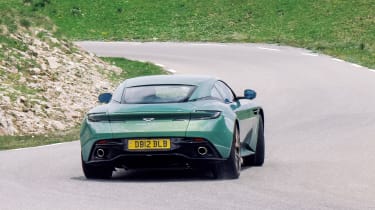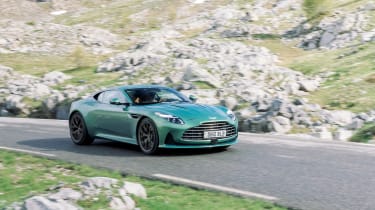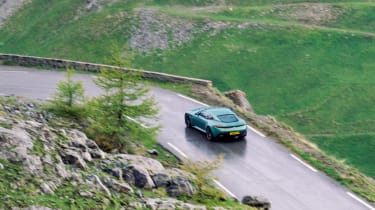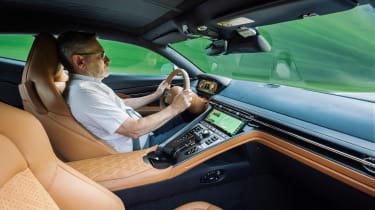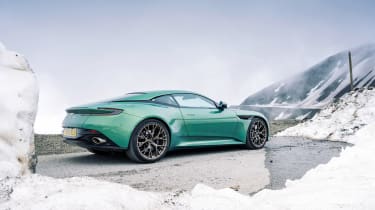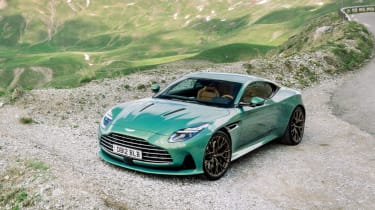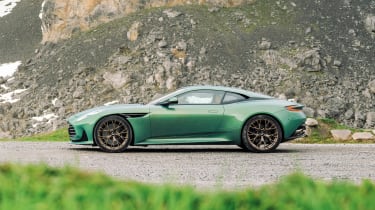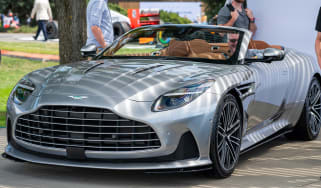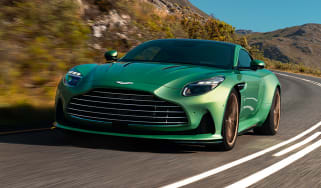Aston Martin DB12 2024 review: a strong first step into a new era
The DB12 marks the beginning of a new chapter for Aston Martin, delivering a more focused, luxurious take on the long-distance GT
‘Sorry, what did you say?’ I ask, backing off a little. ‘I think we must have missed our turn,’ Aston Parrott says again. I back off some more and look around. Hmmm, he’s right; the jagged peaks aren’t where I expected them to be. As we coast along, down the road the tail of the third sports bike disappears around a corner, like a fish wriggling off the hook.
Ten minutes earlier we’d been wandering a French village eating ice creams, having failed to get something proper to eat, again. This time we were an hour early for dinner. Last time we were half an hour late for lunch. As we drove away from the village, three noisy sports bikes came up in the mirror and overtook at the first opportunity, one of them indicating thanks or maybe approving of the DB12 with a shake of the foot, before howling off and cranking into a series of sweeps. It was clear that they were local and knew the road, so I wondered if we could tag along.
Turns out we could. It’s a big car the DB12, a fairly heavy one too, and yet each time I leaned on the grip a bit more the car responded, nailing the precise line. The surface was smooth and warm and the Aston jinked sweetly through a sequence of fast flick-flaks like a car half its size. Confidence up, on every short straight the throttle hit the stop, the 671bhp, twin-turbo V8 whirred and a solid thump of power brought down the gap. After a couple of kilometres we were on the tail of the last bike and had a great view of him leaning hard into the turns. He was dropping back a little from the front two and I was just wondering if a trio-splitting overtake would be rude when a noise broke the spell: ‘I think we must have missed our turn…’.
More reviews
I’d have been happy to carry on but we were absolutely heading in the wrong direction, at speed, and running out of fuel while we did so. ‘Wow,’ I said to Parrott, ‘that was pretty impressive.’ He laughed. The pace and grip were impressive but so too was the steering fidelity, the flat poise, the remarkably neutral balance and the complete lack of slack which made the DB12 feel so exploitable and kind of effortless. It might be an evolution of the DB11 but dynamically it’s capable of going to another level.
Earlier that morning the DB12 had impressed us at 15kmh, managing to turn heads and hold gazes on the streets of Monaco, where supercars are ten-a-penny. I took this as confirmation that the DB12 looks sensational, which I freely admit was not my expectation having seen social media sites comparing press shots of the DB12 with the DB11. From them it looked like a light facelift; a few wrinkles smoothed away here, a bit of filler around the mouth there, but meeting it in the metal it’s strikingly handsome, much more cohesive than DB11, I think because the deeper front grille and painted lower edge and the strong sill balance the shape. The single colour helps too, and it sits perfectly on its bigger diameter, 21in wheels.
The underpinnings of the DB12 are fundamentally DB11 but Aston set themselves the objective of making the car sportier while retaining its GT credentials. During development there was some significant churn at Aston, which still harbours ambitions to be Britain’s Ferrari. This saw the departure of CEO Tobias Moers and the hiring of ex-Ferrari CEO Amedeo Felisa in his place, while Roberto Fedeli, who was head of development for LaFerrari and 458, came on board as Aston’s CTO (chief technical officer). Meanwhile, heading the team tasked with shaping the DB12’s dynamics is Simon Newton, who enjoys the title ‘director of vehicle performance’. He arrived about 15 months ago, in the wake of the departure of chief engineer Matt Becker, and inherited a project that in some respects was quite mature but which needed some strong direction.
‘There was a great ambition to take the performance a long way north but at the same time preserve the car’s GT character,’ says Newton. ‘Some big ticket items were already decided but I wouldn’t say the character of the car was where it is today.’ One of those items was the tyre. After many years with Pirelli, at the behest of Moers, the DB12 is on Michelins, a bespoke version of their brand new Pilot Sport 5S.
Newton says that while they were happy with the rear of the DB12 on the Michelin, and the front end capacity too, they worked hard to get the character of steering they wanted. That involved making the front end structure stiffer laterally than DB11, tying together the rear damper tops for the first time, deleting the steering column isolator (as on the DBS 770 Ultimate), and using the new, adaptive Bilstein dampers to help deliver linearity.
As well as exploiting a new tyre, the dynamics team also had to learn how to get the best from those Bilsteins. ‘It’s a very powerful system with quite a breadth of capacity,’ says Newton. It gave them the opportunity to make the distinction between GT, Sport and Sport+ modes much greater, and the difference wasn’t simply a tweak to the vertical control, says Newton. ‘We spent a lot of time on things like the cornering, controlling the turn-in response, so that everything is well matched in each mode, so that the car feels quite different in each mode.’
If you were looking to attribute one of the DB12’s hardware changes to the influence of Ferrari, it would be the e-diff. Ferrari has long used the electrically activated, locking diffs to help shape the dynamics of its cars but the DB12 is the first Aston to use one. A traditional, mechanical limited slip diff can do a great job but an e-diff can do everything it can do and a whole lot more, with lock-up between zero and 100 per cent on or off the throttle, so it becomes an active part of the car’s dynamic performance, character and control.
The DB12 also has Bosch integrated vehicle control, which Newton describes as ‘an umbrella that looks down on the car and decides what levers to pull to deliver a certain dynamic behaviour’. Its core is an advanced accelerometer, a six-axis IMU (Inertial Measurement Unit), that builds a picture of what the car is doing and therefore knows when an intervention is required. ‘It can pre-empt, anticipate,’ says Newton, ‘so it can come in more modestly and smoothly, without locking the car down. DB12’s braking distances are significantly better because it doesn't have to go into slip to know it's going into slip. It also uses the e-diff as a mechanism, as a dynamic modifier.’
The exterior may have been carefully and effectively reworked but the interior is all new, a clean sheet, and all the better for it, with a bold line running across its width, a new instrument binnacle and a ramp-like centre console. The HMI is custom-made, with fully digital instruments, a large centre screen and a pleasing number of hard keys arranged around a new, stubby auto gear selector. Few will mourn the demise of the individual PRND buttons. The starter button survives but as the centre of the mode switch; you twist its outer collar to cycle between GT, Sport and Sport Plus, and the new Individual and Wet modes.
In the underground car park, the V8 erupts with a roar of traditional cross-plane thunder and fills the space with a grin-inducing wall of sound. The 4-litre, twin-turbo V8 is the only engine option for now but it makes 671bhp, which is 40bhp more than the V12-engined DB11 AMR, so a 12-cylinder version isn’t necessary. Mind, when has it ever been?
It may look tighter and more cohesive but DB12 is still a wide car that sits you low so you can’t see the bonnet, requiring that you use your skill and judgement to escape an underground car park with the fine edges of the forged alloy wheels unscathed. We make it and emerge into the early, crystal light of a Mediterranean morning with our far off destination in the sat-nav. Moments later, we’re on the pit straight of the GP circuit, crossing the start line where, a couple of weeks earlier, Alonso came close to claiming Aston’s first pole position. It always feels like a crazy place to run a GP, like putting on a Rolling Stones gig in your kitchen.
When he’s allowed to choose photo locations, Parrott always comes up with a bit of an adventure and today he’s shunning locations in this area that we might describe as the ‘usual suspects’ for one even further afield that promises to be even more spectacular: the Col de la Bonette. The risk is that the highest paved road in France is closed. The guide says it’s open from June to October, so we’re taking a chance but, seduced by the warmth of the Cote d’Azur, we decide to go for it. What’s the worst that could happen, Parrott laughs.
Initially, the DB12’s ride feels decent and the gearbox relaxed but responsive. Clear of the principality, the hammer goes down and the Aston shows us what it’s got. And it’s got a lot. The acceleration is a proper kidney punch, the urge sustained through a couple of upshifts. Anyone who wants a V12 DB12 only wants it for the noise, but that’s as valid a reason as any, especially as the twin-turbo V8’s aural character isn’t strong. That said, its 671bhp and 590lb ft – up almost 150bhp and 90lb ft on the V8 DB11 – is all the urge you could reasonably need. The new, stronger eight-speed ZF has the same ratios as before but a shorter final drive, further enhancing acceleration. Aston claims 0-60mph in just 3.4sec and a top speed of 202mph.
After a couple of hours mostly meandering with slow traffic towards our objective, a few things are becoming clear. The seats are firm but comfortable and supportive, the instruments are neat but the smaller typefaces too small, and the gearbox is unobtrusively excellent and then crisp and decisive when opportunities arise. When the hammer goes down there’s never any shortage of almost instant urge from the engine and, impressively, the rear tyres – huge 325 section - never have any trouble converting it all into forward motion. If the stability control system is managing anything other than the e-diff when the torque hits, you get no sense that any of the V8’s urge is being withheld. You ask, the car delivers.
We arrive at a T-junction and a sign tells us that the gamble has paid off: the col is open. We start climbing and it’s not long before the trees thin out and we are presented with epic views. The odd thing is, from the tree line to the snowy summit the surface is superb, smooth and unblemished, but the lower section is properly lumpy and weather-ravaged. And the DB12 does not like lumpy, even in GT mode, which should be the go-to mode for general use. There were a couple of hints of this in Monaco, patches of broken asphalt that bought a sharp reaction, but here the toughness of the ride is inescapable.
The ribbon of road twists ever higher, a seemingly endless, inviting series of corners. Yet as we climb, my foot gets lighter and lighter on the throttle because the views get ever more extraordinary. What an astonishing place. We make the top, almost; the actual peak is a couple of hundred meters higher but we don’t have the time (or inclination) to hoof it to the 2860m summit.
It's not especially busy, so for long spells we feel like we have the place to ourselves. The DB12’s steering is well weighted, precise and linear but it lacks feel, that tactility that connects you to the tread blocks and makes you feel properly immersed in the dynamics. It’s not crucial around town and it’s less important than the whole vehicle response when, say, you’re chasing down a motorbike or three, but everywhere in between, detailed steering feel rewards and validates your input. The DB12’s lack makes it feel a little clinical.
With traction off and an early stab of throttle the torque is irresistible, unsticking the broad Michelins and kicking the rear wide quite abruptly, requiring a quick armful of opposite lock. It’s all a bit academic because the first customer DB12s will be fitted with a scalable traction control which, if it works as well as the similar system on the BMW M3 and M4, will be a revelation. It will allow you to set the slip to a level from 0 to 10, so you can use the power to gently and subtly steer the rear, or allow greater slip angles up to a point, or wind it off entirely.
For drivers who like to feel fully in control of a car’s balance, it should make the DB12 much more approachable and exploitable. A little later, we got an idea of how the it might feel. Hunger drove us back down to the village at the foot of the col in search of lunch, and as we set off up again, still hungry, dark skies matched our mood, and then it rained hard. With reduced grip the DB12 was playful, breaking away more readily and softly and offering good throttle adjustability. There’s no doubting the muscle of the V8 and you meter out its torque pretty well but it’s a little light on aural character. Turbos mute the intake, GPFs mute the tailpipe noise, yet there is the opportunity to infill a bit more of the missing tone because the engine note is augmented through the Bowers and Wilkins sound system.
We decided to head over the top and explore the other side, which turned out to be even more spectacular but, frustratingly, no more accommodating on the food front. So, having played nicely with the motorbikes, we topped up with fuel and headed back up the col. We’d just bagged the last shot when it began to rain again. As we climbed the rain became harder and then turned to hail, and then I was steering left but the car was going off the road to the right because the rippled surface wasn’t rain wash, it was slush. Luckily we were heading to the inside not the outside, with its complete lack of armco and scary drops. The DB12’s front tyres regained grip just before we ran its lovely wheels against the jagged rocks and we scrabbled on up, having decided going up would be less terrifying than going down. After a tense few minutes we were out of the shower and we had our answer: this was the worst that could happen.
At almost midnight, we were back in Monaco playing a sort of snakes and ladders with the tunnels and elevated sections, that saw us get within 100 yards of the hotel before we tiredly wrong-slotted and headed down a tunnel that spat us out on the outskirts again. By this time, my thoughts on the DB12 had long crystallised.
Aston has achieved its goal of elevating the performance of DB12 far above DB11 – and north of its arch rival the Ferrari Roma too. It’s a great looking car with an interior to match and delivers stunning urge with exceptional control and precision; for such a big car it’s remarkably capable and composed at speed. However, in the process it’s lost some of its Grand Tourer qualities. Aston describes it as a ‘super tourer’ but a 2+2 coupe of this size needs to be relaxed when it’s not going for it and currently the low speed ride is too brittle. Also, while there’s terrific grip and the steering is accurate and linear, there’s a lack of feel and feedback that leave you craving engagement. The fundamentals are there – DB12 is a much more convincing and capable car than DB11 – it just needs more polish.
Price and rivals
At £185,000 (or close enough, in this upper end of the market manufacturers don’t like to commit to a list price), the DB12 is sandwiched between Ferrari’s Roma and Bentley’s Continental GT V8 S. The Italian being the cheapest of the quartet, yes really. There's is also the new V6-engined Maserati GranTurismo Trofeo to consider and Mercedes-AMG's new 2+2 AMG GT 63.
Of course no Roma has ever been delivered without an option or several fitted so, like all the cars here its £176,631 list price is a little immaterial but it’s a starting point. With the Roma you’re getting Ferrari’s interpretation of a GT car, which is to say one that’s borderline supercar with razor sharp dynamics, the Italian’s traditional quick steering adds to the sharpness and the V8’s willingness to rev and rev and rev is as addictive as its ability to switch to a long-legged cruiser is impressive. A comparison with a DB12 will be fascinating.
The evolution of Porsche’s £180,600 911 Turbo S in a world of GT3s means the original superfast 911’s role is now a far wider one with its ability to still monster every performance metric on the table while doing so with an unexpected element of GT refinement. There’s more tyre noise than others that class themselves as pure GTs and it leaves the quilted leather and chrome switchgear to others, but the Turbo S can be considered a supercar and GT in equal measure, although it doesn’t balance these traits as well the DB12.
Quintessentially a GT car first and foremost Bentley’s £198,600 Continental GT V8 S is peak GT for many. It has a level of luxury beyond compare, although the new DB12 runs it close, the hours that go into creating the interior detail is today’s link to Bentley’s craftsmanship of the past. There are few cars that feel as special to be in than a modern Bentley. Its underpinnings, shared heavily with Porsche’s latest Panamera, make for a Conti GT that’s as good to drive as it is to be driven in. The stodginess of the original has been banished, replaced with exemplary body control, tight dynamics and a willingness to enjoy its performance beyond a straight line race to the Mediterranean.
Now there's Maserati's new £163,000 GranTurismo to consider. Its MC20 sourced Nettuno twin-turbochsrged V6 might give away two-cylinders to its front engined rivals here, but its 542bhp and 479lb ft still feels explosively quick. Like the Porsche and the Bentley, it too is four-wheel drive, although it's one of the most unobtrusive systems we've tried, ready in the background rather than interfering. The GranTurismo feels a more accomplished driver's GT car than the Bentley, but doesn't have the dynamic sharpness of the Roma.
The latest edition to this super-GT category is the new (circa) £160,000 Mercedes-AMG GT 63. It might share the same 4-litre hot-vee twin-turbocharged V8 as the Aston along with its nine-speed gearbox, but the AMG 'only' has 577bhp and 590lb ft of torque. But the new GT is now much more clearly defined (AMG said the previous model was a supercar, we thought it closer to a confused GT car) and what it gives away in power to the Aston it makes up for with a an armoury of chassis technology that makes a strong rival in this competitor set.
Why it made eCoty 2023
Is it a GT car or is it a supercar? Aston Martin thinks its new DB12 operates in both camps and has therefore declared that it has created the first ‘super tourer’. With 671bhp from its AMG-sourced twin-turbocharged V8 it has the ‘super’ bit covered, but the greatest supercars aren’t simply defined by their numbers; if that was the case, electric hypercars wouldn’t be parked unsold, gathering dust.
Supercars offer so much more than raw performance and our first drive of the DB12 earlier in 2023 suggested that Aston’s new 2+2 has some convincing to do when it comes to playing the supercar role. It’s far more convincing as a grand tourer, although in pursuit of super-performance some of the expected refinement has been left on the shelf, but not at the cost of the sense of occasion.
Both to look at and to sit in, the DB12 is a striking piece of design and craftsmanship. In this company and on this test the DB12 will need to call upon all of its core attributes on every occasion. While in isolation it’s proven to be a fine driver’s car that is immensely satisfying and richly rewarding with a deep sense of desirability, a standout car in eCoty needs to go that extra mile.
Aston Martin has clearly gone the distance with the car’s development, polishing the areas that needed it while overhauling those that were past their best. Only 20 per cent of the car is carried over from the DB11. A great deal hangs on the DB12’s success, not only in this test but in the wider market, for it sets the template for the next generation of Aston Martins. No pressure, DB12.



